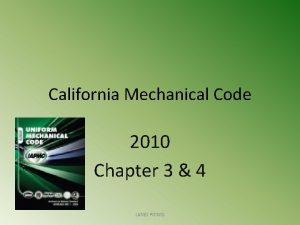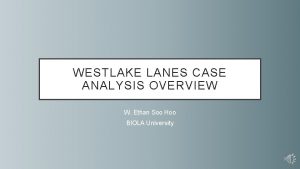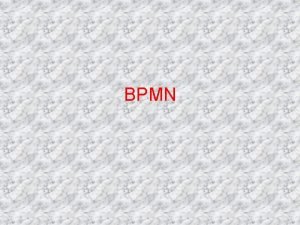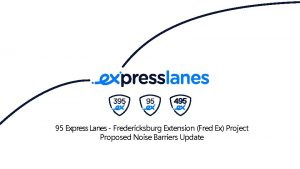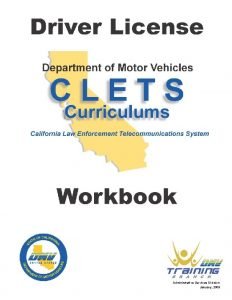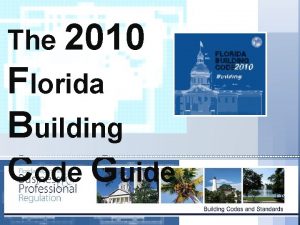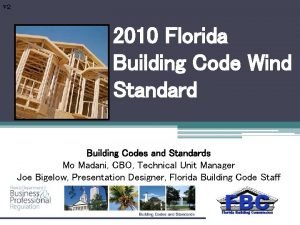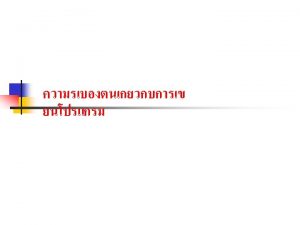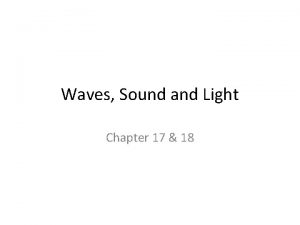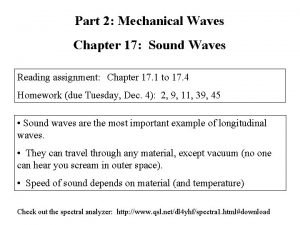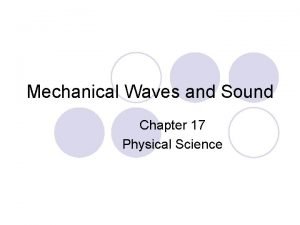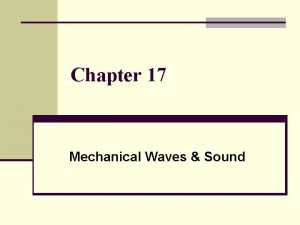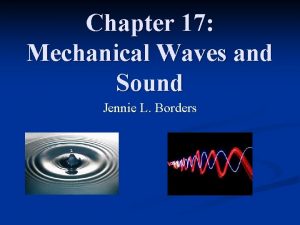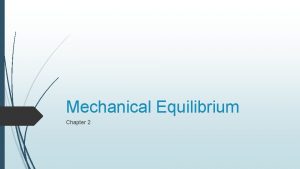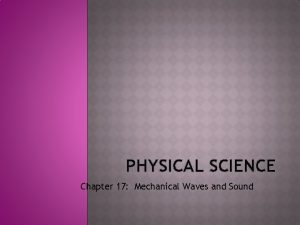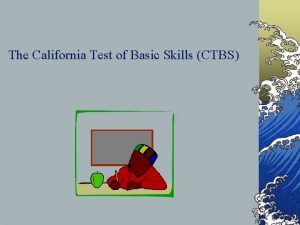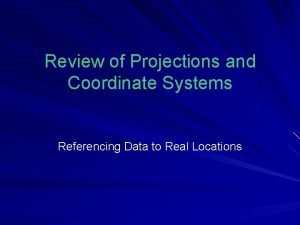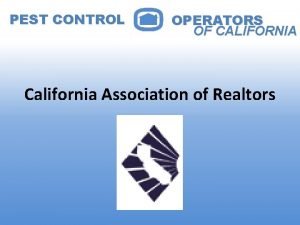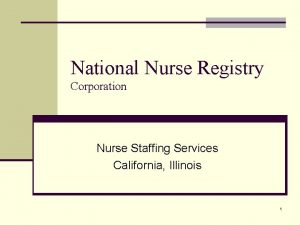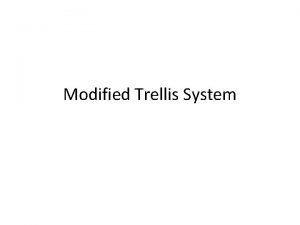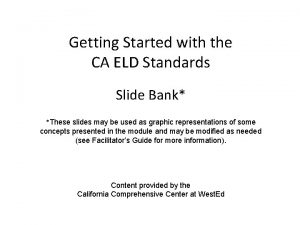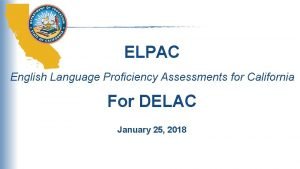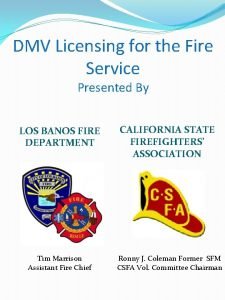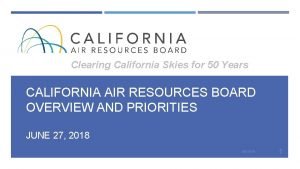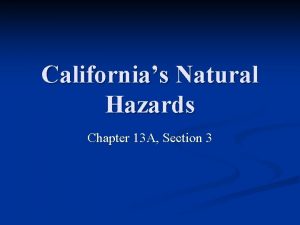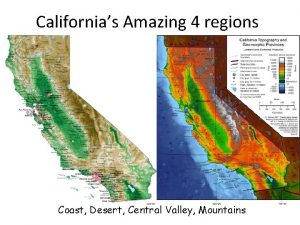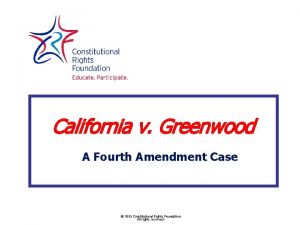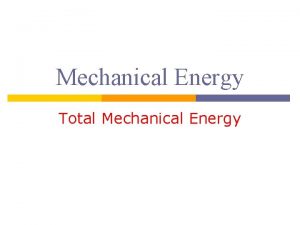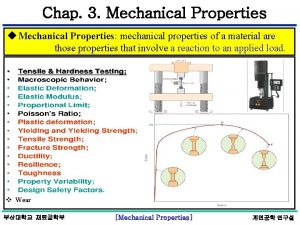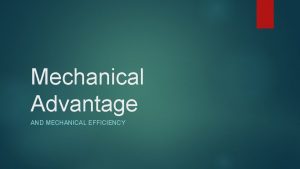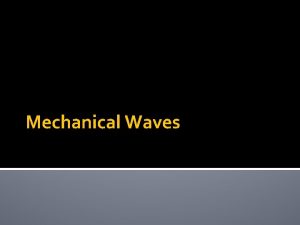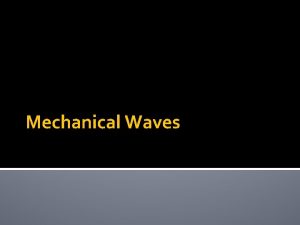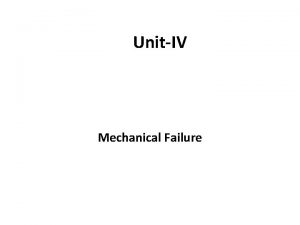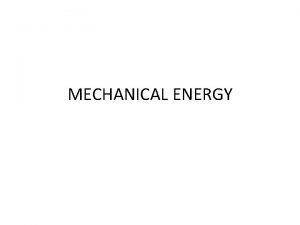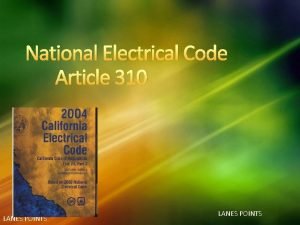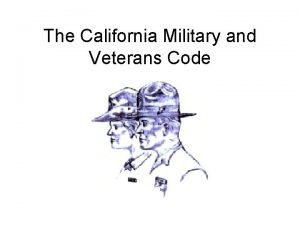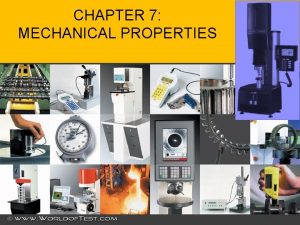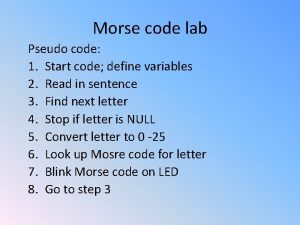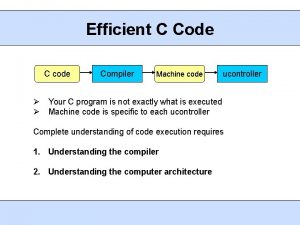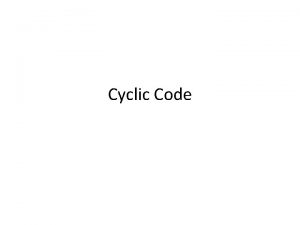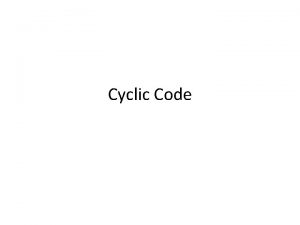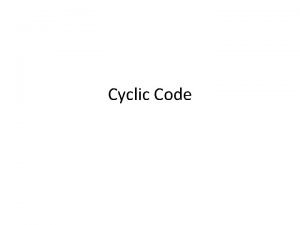California Mechanical Code 2010 Chapter 3 4 LANES
































































![Chapter 4 Ventilation and Air Supply • • • [OSHPD 1, 2, 3, 4] Chapter 4 Ventilation and Air Supply • • • [OSHPD 1, 2, 3, 4]](https://slidetodoc.com/presentation_image_h/969d536a9e14eee6826faee3b546fe26/image-65.jpg)
- Slides: 65

California Mechanical Code 2010 Chapter 3 & 4 LANES POINTS

Chapter 3 General Requirements Installation LANES POINTS

Chapter 3 General Requirements • 301. 0 - Scope – This chapter covers general requirements for heating, ventilating, air-conditioning, refrigeration, miscellaneous heat-producing, and energy-utilizing equipment. Such equipment shall conform to the requirements of this code. – Equipment shall not be installed or altered in violation of this code, nor shall the fuel input rate to equipment be increased in excess of the approved Btu/h (k. W) rating at the altitude where it is being used. – Defective material or parts shall be replaced in such a manner as not to invalidate any approval. LANES POINTS

Chapter 3 General Requirements Installation • 303. 0 Installation: • 303. 1 Listed Appliances. Except as otherwise provided in the code, the installation of appliances regulated by this code shall conform to the conditions of listing. The appliance installer shall leave the manufacturer's installation and operating instructions attached to the appliance. Clearances of listed appliances from combustible materials shall be as specified in the listing or on the rating plate. LANES POINTS

Chapter 3 General Requirements Installation “Listed appliances” as defined in Chapter 2 part 214. 0: Listed and Listing. SFMJ "Listed" and "Listing" are terms referring to equipment or materials included in a list published by an approved testing laboratory, inspection agency, or other organization concerned with product evaluation that maintains periodic inspection of current productions of listed equipment or materials and which listing states that the material or equipment complies with approved nationally recognized codes, standards, or tests and has been tested or evaluated and found suitable for use in a specific manner. These terms shall also mean equipment or materials accepted by the State Fire Marshal as conforming to the provisions of these regulations and which are included in a list published by the State Fire Marshal. LANES POINTS

Chapter 3 General Requirements Installation • 303. 3 Unlisted Appliances. – Unlisted appliances shall be installed with the standard clearances from combustible construction specified in Table 3 -2. Unlisted appliances may have the standard clearances of Table 3 -2 reduced by employing the forms of protection specified in Table 3 -3. Forms of protection specified in Table 3 -3 may be utilized to reduce clearances to combustible construction for all applicable appliances. LANES POINTS

Chapter 3 General Requirements Installation • 303. 2 Room Large in Comparison to Size of Equipment. – Central-heating furnaces not listed for closet or alcove installation shall be installed in a room or space having a volume at least twelve (12) times the total volume of the furnace; central-heating boilers not listed for closet or alcove installation shall be installed in a room or space having a volume sixteen (16) times the volume of the boiler. [OSHPD 1, 2, 3 & 4] The total volume of the boilers shall be based on the total number of central-heating boilers that can operate at the same time. LANES POINTS

LANES POINTS

LANES POINTS

LANES POINTS

Chapter 3 General Requirements Installation • 303. 4 Anchorage of Appliances. – Appliances designed to be fixed in position shall be securely fastened in place. Supports for appliances shall be designed and constructed to sustain vertical and horizontal loads within the stress limitations specified in the Building Code. This means that the appliance (if suspended with straps or rods) must be prevented from having vertical and lateral movement. LANES POINTS

304. 4 Anchorage of Appliances Does this meet the sprit of the code? LANES POINTS

Chapter 3 General Requirements Installation • 303. 6 Identification of Equipment. – When more than one heating, cooling, ventilating, or refrigerating system is installed on the roof of a building or within a building, it shall be permanently identified as to the area or space served by the equipment Paint on the unit’s control panel, with an identifier like the apartment or condo’s number is acceptable. LANES POINTS

303. 6 Identification of Equipment Easy to find the right condensing unit when well marked and identified. LANES POINTS

Chapter 3 General Requirements Installation 303. 8 Equipment on Roofs. 304. 1 Access to Equipment on Roofs. LANES POINTS

Chapter 3 General Requirements Installation • 304. 1. 2. 1 Door or Scuttle – The inside means of access shall be a permanent or foldaway inside stairway or ladder, terminating in an enclosure, scuttle, or trap door. – Such scuttles or trap doors shall be at least twenty -two (22) inches x twenty-four (24) inches (560 mm x 610 mm) in size, shall open easily and safely under all conditions, especially snow, and shall be constructed so as to permit access on the inside. LANES POINTS

Chapter 3 General Requirements Installation • 303. 8. 1. 5 Guards or Rails. – At least six (6) ft. (1, 829 mm) between any part of the equipment and the edge of a roof or similar hazard, or rigidly fixed rail, guards, parapets, or other building structures at least forty-two (42) inches (1, 067 mm) in height shall be provided on the exposed side. LANES POINTS

303. 8. 1. 5 – Any panel 6 feet from the edge or guard rails 42” in height shall be provided LANES POINTS

Chapter 3 General Requirements Installation • 303. 8. 1. 6 Electrical Power. – All equipment requiring an external source of electrical power for its operation shall be provided with: 1) Readily accessible electrical disconnecting means within sight of the equipment. 2) A 120 VAC grounding-type receptacle outlet on the roof adjacent to the equipment. The receptacle outlet shall be on the supply side of the disconnect switch. LANES POINTS

Chapter 3 General Requirements Installation • 304. 0 Service and Access to Equipment and Appliances. – Equipment and appliances shall be accessible for inspection, service, repair, and replacement without removing permanent construction. Sufficient clearance shall be maintained to permit cleaning of heating surfaces; the replacement of filters, blowers, motors, burners, controls, and vent connections; the lubrication of moving parts where necessary; the adjustment and cleaning of burners and pilots; and the proper functioning of explosion vents, if provided. [NFPA 54 -09: 9. 2. 1] Unless otherwise specified, not less than thirty (30) inches (762 mm) in depth, width, and height of working space shall be provided. LANES POINTS

Chapter 3 General Requirements Installation LANES POINTS

Chapter 3 General Requirements Installation – Exception: • Unit heaters and room heaters may be installed with an eighteen (18) inch (457 mm) minimum depth working space. A platform shall not be required for unit heaters or room heaters. The operating instructions shall be attached to the appliance where they can be read easily. LANES POINTS

Chapter 3 General Requirements Installation • 304. 1 Access to Equipment on Roofs. – 304. 1. 1 General. • Equipment and appliances located on roofs or other elevated locations shall be accessible. [NFPA 54: 9. 4. 3. 1] – 304. 1. 2 Access from Inside. • Buildings of more than fifteen (15) feet (4, 572 mm) in height shall have an inside means of access to the roof, unless other means acceptable to the Authority Having Jurisdiction are used. [NFPA 54: 9. 4. 3. 2] LANES POINTS

Chapter 3 General Requirements Installation Should not have been approved. You can’t access this without breaking tiles. LANES POINTS

Chapter 3 General Requirements Installation • 304. 1. 2. 1 Door or Scuttle. – The inside means of access shall be a permanent or foldaway inside stairway or ladder, terminating in an enclosure, scuttle, or trap door. Such scuttles or trap doors shall be at least twenty-two (22) inches x twenty-four (24) inches (560 mm x 610 mm) in size, shall open easily and safely under all conditions, especially snow, and shall be constructed so as to permit access on the inside. LANES POINTS

Chapter 3 General Requirements Installation • 304. 1. 2. 2 Guards or Rails. – At least six (6) feet (1, 829 mm) of clearance shall be available between the access opening and the edge of the roof or similar hazard, or rigidly fixed rails or guards a minimum of forty-two (42) inches (1, 067 mm) in height shall be provided on the exposed side. Where parapets or other building structures are utilized in lieu of guards or rails, they shall be a minimum of forty-two (42) inches (1, 067 mm) in height. [NFPA 54: 9. 4. 3. 3] LANES POINTS

Chapter 3 General Requirements Installation This installation should not be allowed. Clearly it is unsafe to service. LANES POINTS

Chapter 3 General Requirements Installation • 304. 1. 3 Permanent Lighting. – Permanent lighting shall be provided at the roof access. The switch for such lighting shall be located inside the building near the access means leading to the roof. [NFPA 54: 9. 4. 3. 4] LANES POINTS

Chapter 3 General Requirements Installation • 305. 0 Automatic Control Devices – Heating appliances shall be equipped with a listed device or devices that will shut off the fuel supply to the main burner or burners in the event of pilot or ignition failure. In addition, liquefied petroleum gas-air-burning heating appliances shall be equipped with a listed automatic device or devices that will shut off the flow of gas to the pilot in the event of ignition failure: LANES POINTS

305. 0 Automatic Control Devices LANES POINTS

Chapter 3 General Requirements Installation • 305. 0 Automatic Control Devices – Forced-air and gravity-type warm-air furnaces shall be equipped with a listed air outlet temperature limit control that cannot be set for temperatures higher than 250°F (121°C). Such controls shall be located in the bonnet or plenum, within two (2) feet (610 mm) of the discharge side of the heating LANES POINTS

Chapter 3 General Requirements Installation • 306. 0 Labeling. – 306. 1 Fuel-Burning Appliances. Fuel-burning heating appliances shall bear a permanent and legible factoryapplied nameplate on which shall appear: • 306. 1. 1 The manufacturer’s name. • 306. 1. 2 The approved fuel input rating of the appliance, expressed in Btu/h (W). • 306. 1. 3 The model and serial number. • 306. 1. 4 Instructions for the lighting, operation, and shutdown of the appliance. • 306. 1. 5 The type of fuel approved for use with the appliance. • 306. 1. 6 The symbol of an approved agency certifying compliance of the equipment with recognized standards. 306. 1. 7 Required clearances from combustible surfaces on which or adjacent to which it may be mounted. LANES POINTS

Chapter 3 General Requirements Installation • 307. 1 Protection Against Damage. – Appliances installed in garages, warehouses, or other areas subject to mechanical damage shall be guarded against such damage by being installed behind protective barriers or by being elevated or located out of the normal path of vehicles. – Heating and cooling equipment located in a garage and that generates a glow, spark, or flame capable of igniting flammable vapors shall be installed with the pilots and burners or heating elements and switches at least eighteen (18) inches (457 mm) above the floor level. – Where such appliances installed within a garage are enclosed in a separate, approved compartment having access only from outside of the garage, such appliances may be installed at floor level, provided the required combustion air is taken from and discharged to the exterior of the garage. LANES POINTS

Chapter 3 General Requirements Installation • 308. 0 Electrical Connections. – Equipment regulated by this code requiring electrical connections of more than fifty (50) volts shall have a positive means of disconnect adjacent to and in sight from the equipment served. A 120 volt receptacle shall be located within twenty-five (25) feet (7, 620 mm) of the equipment for service and maintenance purposes. The receptacle need not be located on the same level as the equipment. – Low-voltage wiring of fifty (50) volts or less within a structure shall be installed in a manner to prevent physical damage. Some cities may require “direct high voltage wiring” to the appliance. LANES POINTS

Chapter 3 General Requirements Installation • 309. 1 Condensate Disposal. – Condensate from air washers, air-cooling coils, fuel-burning condensing appliances, and the overflow from evaporative coolers and similar water-supplied equipment or similar airconditioning equipment shall be collected and discharged to an approved plumbing fixture or disposal area. If discharged into the drainage system, equipment shall drain by means of an indirect waste pipe. The waste pipe shall have a slope of not less than 1/8 inch per foot (10. 5 mm/m) or 1 percent slope and shall be of approved corrosion-resistant material not smaller than the outlet size as required in either Section 309. 3 or 309. 4 for aircooling coils or condensing fuel-burning appliances, respectively. – Condensate or wastewater shall not drain over a public way. LANES POINTS

Chapter 3 General Requirements Installation • 309. 2 Condensate Control. – When a cooling coil or cooling unit is located in an attic or furred space where damage may result from condensate overflow, an additional watertight pan of corrosionresistant metal shall be installed beneath the cooling coil or unit top to catch the overflow condensate due to a clogged primary condensate drain, or one pan with a standing overflow and a separate secondary drain may be provided in lieu of the secondary drain pan. The additional pan or the standing overflow shall be provided with a drain pipe, minimum 3/4 inch (19. 1 mm) nominal pipe size, discharging at a point that can be readily observed. – This requirement is in addition to the requirements in Sections 309. 3 and 309. 4. LANES POINTS

Chapter 3 General Requirements Installation • 309. 4 Fuel-Burning Appliance Condensate Drains. – Condensate drain lines from individual fuelburning condensing appliances shall be sized according to the manufacturer's recommendations. – Condensate drain lines serving more than one appliance shall be approved by the Authority Having Jurisdiction prior to installation. LANES POINTS

Chapter 3 General Requirements Installation • 311. 2 Air Filters. – Air filters shall be installed in a heating; cooling, or makeup air system. Such filters shall comply with the standard, Air Filter Units, Test Performance of, that is referenced in Chapter 17, as Class I or II filters. – Exception: • Systems serving single guest rooms or dwelling units shall not require a listed filter. LANES POINTS

Chapter 3 General Requirements Installation • 311. 3 Prohibited Source. – Outside or return air for a heating or cooling air system shall not be taken from the following locations: 1) Closer than ten (10) feet (3, 048 mm) from an appliance vent outlet, a vent opening of a plumbing drainage system, or the discharge outlet of an exhaust fan, unless the outlet is three (3) feet (914 mm) above the outside-air inlet. 2) Where it is less than ten (10) feet above the surface of any abutting public way, driveway, sidewalk, street, alley or driveway. 3) A hazardous or insanitary location or a refrigeration machinery room as defined in this code. 4) From an area, the volume of which is less than 25 percent of the entire volume served by such system, unless there is a permanent opening to an area the volume of which is equal to 25 percent of the entire volume served. LANES POINTS

Chapter 3 General Requirements Installation • 311. 3 Prohibited Source. 4) From an area, the volume of which is less than 25 percent of the entire volume served by such system, unless there is a permanent opening to an area the volume of which is equal to 25 percent of the entire volume served. EXCEPTION: Such openings when used for a heating or cooling air system in a dwelling unit shall be permitted to be reduced to not less than 50 percent of the required area, provided the balance of the required return air is taken from a room or hall having not less than three (3) doors leading to other rooms served by the furnace. 5) 6) A closet, bathroom, toilet room, or kitchen. From rooms or spaces containing a fuel-burning appliance therein. Where such room or space serves as source of return air. There additional exceptions and restrictions, see your CMC book. LANES POINTS

Chapter 3 General Requirements Installation • 311. 4 Return-Air Limitations: – Return air from one dwelling unit shall not discharge into another dwelling unit through the heating or cooling air system. LANES POINTS

Chapter 4 Ventilation And Air Supply LANES POINTS

Chapter 4 Ventilation and Air Supply • 401. 0 General – This chapter contains requirements for ventilation air supply and exhaust, evaporative cooling systems, and makeup-air requirements for directgas-fired heaters, industrial air heaters, and miscellaneous heaters. Most new construction since 2001 will have the ventilation engineering performed by a licensed engineer as per California Energy Code Requirements set in the Residential Compliance Manual 2008. I am presenting this information here to promote awareness of the need for proper ventilation. LANES POINTS

Chapter 4 Ventilation and Air Supply • 402. 0 Ventilation Air • 402. 1 General Requirements. – [Not permitted for OSHPD 1, 2, 3 & 4] [See section 4. 04 through 418. 0 (SFM) • All rooms and occupied spaces listed in Table 4 -1 shall be designed to have ventilation (outdoor) air for occupants in accordance with this chapter. Ventilation air supply requirements for occupancies regulated by the California Energy Commission are found in the California Energy Code. LANES POINTS

Chapter 4 Ventilation and Air Supply • 402. 2 Natural Ventilation. – Use of natural ventilation systems designed in accordance with this section shall be permitted in lieu of or in conjunction with mechanical ventilation systems. [ASHRAE 62. 1: 5. 1] • Exception: An engineered natural ventilation system when approved by the Authority Having Jurisdiction need not meet the requirements of 402. 2. 1 and 402. 2. 2. [ASHRAE 62. 1: 5. 1] LANES POINTS

Chapter 4 Ventilation and Air Supply • 402. 2. 1 Location and Size of Openings. – Naturally ventilated spaces shall be permanently open to and within twenty-five (25) feet (7, 620 mm) of operable wall or roof openings to the outdoors, the openable area of which is a minimum of 4 percent of the net occupiable floor area. Where the openings are covered with louvers or otherwise obstructed, openable area shall be based on the free unobstructed area through the opening. Where interior spaces without direct openings to the outdoors are ventilated through adjoining rooms, the opening between rooms shall be permanently unobstructed and have a free area of not less than 8 percent of the area of the interior room nor less than 25 ft 2 (2. 3 m 2). [ASHRAE 62. 1: 5. 1. 1] LANES POINTS

Chapter 4 Ventilation and Air Supply • 402. 2. 2 Control and Accessibility. – The means to open required operable openings shall be readily accessible to building occupants whenever the space is occupied. [ASHRAE 62. 1: 5. 1. 2] LANES POINTS

Chapter 4 Ventilation and Air Supply • 402. 3 Mechanical Ventilation. – Where natural ventilation is not permitted by this section or the Building Code, mechanical ventilation systems shall be designed, constructed, and installed to provide a method of supply air and exhaust air. The system shall operate so that all rooms and spaces are continuously provided with the required ventilation rate while occupied. LANES POINTS

Chapter 4 Ventilation and Air Supply • 403. 0 Ventilation Rates. • [Not permitted for OSHPD 1, 2, 3 & 4] – The design outdoor air intake flow rate for a ventilation system shall be determined in accordance with Sections 403. 1 through 403. 6: • 403. 1. 1 Breathing Zone Outdoor Airflow • 403. 1. 2 Zone Air Distribution Effectiveness • 403. 1. 3 Zone Outdoor Airflow LANES POINTS

Chapter 4 Ventilation and Air Supply • 403. 2 Single-Zone Systems. – When one air handler supplies a mixture of outdoor air and recirculated air to only one zone, the outdoor air intake flow (Vot) shall be determined in accordance with Equation 4 -3. [ASHRAE 62. 1: 6. 2. 3] LANES POINTS

Chapter 4 Ventilation and Air Supply • 403. 2 Single-Zone Systems Vot = Outdoor air intake flow Voz = Zone outdoor airflow [403. 1. 3] Vbz = breathing zone outdoor airflow [403. 1. 1] Ez = system ventilation efficiency [found in table 4 – 3] (see CMC section related to ventilation for complete math formulae) Vot = Vbz / Ez LANES POINTS

Chapter 4 Ventilation and Air Supply What if I had a 3 bedroom 2 bath 1200 square foot residential home, ceiling supply and ceiling return, that required ventilation to meet the new CMC standard under ASHREA standard 62. 1 # of people = # of bedrooms + 1 Facts: 1200 square feet 4 occupants Ceiling diffusers and return LANES POINTS

Chapter 4 Ventilation and Air Supply • 403. 2 Single-Zone Systems Vot = Voz [403. 2] Vot = (Vbz / Ez) [403. 1. 3 using Table 4 - 1] Vot = (Rp. Pz + Ra. Az) / Ez[403. 1. 1 using Table 4 - 2] Rp = outdoor airflow rate required person as determined from Table 4 – 1 Pz = Zone Population [The largest number of people expected to occupy the zone during typical usage] Ra = outdoor airflow rate required per unit area as determined from Table 4 – 1 Az = Zone Floor Area LANES POINTS

Chapter 4 Ventilation and Air Supply Vot = (Rp. Pz + Ra. Az) / Ez Vot = (5 * 4) + (0. 06 * 1200) / 1. 0) Vot = 20 + 72 Vot = 92 cfm Total ventilation required for a 1200 sq. ft. 3 bedroom home with ceiling supply / return single zone [single system] = 92 cfm LANES POINTS

Chapter 4 Ventilation and Air Supply • You would provide exhaust ventilation through the bathroom exhaust at a rate of 50 cfm per bathroom while having a fresh air intake on the heating and air conditioning system return using a barometric damper and filters to provide make-up air. This balance would meet ASHREA 62. 1 – (The exhaust would pull air through the HVAC system – although not running 24/7) LANES POINTS

Chapter 4 Ventilation and Air Supply • • 403. 3 100% Outdoor Air Systems 403. 4 Multiple Zone Recalculating Systems 403. 4. 2 System Ventilation Efficiency 403. 4. 4 Outdoor Air Intake 403. 5 Design for Varying Operating Conditions 403. 6 Dynamic Reset 403. 7 Exhaust Ventilation LANES POINTS

Chapter 4 Ventilation and Air Supply • 403. 8 Exhaust Ventilation for Enclosed Parking Garages. – Exhaust airflow for enclosed parking garages shall be provided in accordance with the requirements in Table 4 -4 and this Section. Exhaust makeup air shall be permitted to be any combination of outdoor air or transfer air. LANES POINTS

Chapter 4 Ventilation and Air Supply • 403. 8. 1 Exhaust Inlet Distribution. – To ensure proper exhaust of contaminated air and fumes from parking garages, exhaust systems utilizing multiple exhaust inlets shall be designed so that exhaust inlets are distributed in such a manner that no portion of the parking garage is more than 50 feet (15 240 mm) from an exhaust inlet. Such exhaust inlets shall be installed so that the highest elevation of the exhaust inlet is no greater than 12 inches (305 mm) below the lowest ceiling level. • Exception: Garage exhaust systems designed without distributed exhaust inlets shall have their exhaust inlets designed based on the principles of engineering and mechanics and shall provide the minimum required exhaust rate in Table 4 -4. LANES POINTS

Chapter 4 Ventilation and Air Supply • 404. 0 Makeup Air. – Makeup-air requirements for direct gas-fired heaters, industrial air heaters, and miscellaneous heaters are found in Chapters 5 and 9 LANES POINTS

Chapter 4 Ventilation and Air Supply • 405. 0 Evaporative Cooling Systems – Evaporative cooling systems shall comply with this chapter. – Evaporative cooling systems shall be provided with outside air as specified for cooling systems in this code. – Air ducts and fire dampers that are a portion of an evaporative cooling system shall comply with this code. LANES POINTS

Chapter 4 Ventilation and Air Supply • 405. 3 Installation. – An evaporative cooler supported by the building structure shall be installed on a substantial level base and shall be secured directly or indirectly to the building structure by suitable means to prevent displacement of the cooler. – Modifications made to the supporting framework of buildings as a result of the installation shall be in accordance with the requirements of the Building Code. Openings in exterior walls shall be flashed in an approved manner in accordance with the requirements of the Building Code. – An evaporative cooler supported directly by the ground shall be isolated from the ground by a level concrete slab extending not less than three (3) inches (76 mm) above the adjoining ground level. – An evaporative cooler supported on an aboveground platform shall be elevated at least six (6) inches (152 mm) above adjoining ground level. LANES POINTS

Chapter 4 Ventilation and Air Supply • 405. 4 Evaporative Cooling System for Health Care Facilities. [For OSHPD 1, 2, 3 & 4] – Direct evaporative cooling systems where the air directly contacts the wetted surface or spray shall be limited in health facilities to non-patient areas such as laundry rooms, food preparation areas, and boiler or machinery rooms. Similar rooms with high heating producing equipment will be considered when specifically approved by the enforcing agency. The evaporative pads shall be a synthetic type. Filters shall be required in accordance with Tables 4 -B and 4 -C except utility rooms, i. e. : boiler or machinery rooms. LANES POINTS

Chapter 4 Ventilation and Air Supply • 407. 0 Ventilation System Details. [OSHPD 1, 2, 3 & 41 407. 1 General – 407. 1. 1 All supply-air, return air, and exhaust-air systems shall be mechanically operated and such systems for areas listed in Table 4 -A shall be operated continuously. Natural ventilation through windows or other openings such as louvers will be considered as supplemental to the required mechanical ventilation systems. • Exceptions: LANES POINTS

Chapter 4 Ventilation and Air Supply – Natural ventilation shall not be used in airborne infection isolation rooms and protective environment rooms. – The number of air changes may be reduced to 25 percent of the indicated value in Table 4 -A, when the room is unoccupied, if provisions are made to ensure the following: 1. The number of air changes per hour indicated is reestablished whenever the space is occupied. 2. The pressure relationship with the surrounding rooms is maintained when the air changes per hour are reduced. See CMC entire text for complete exemptions LANES POINTS
![Chapter 4 Ventilation and Air Supply OSHPD 1 2 3 4 Chapter 4 Ventilation and Air Supply • • • [OSHPD 1, 2, 3, 4]](https://slidetodoc.com/presentation_image_h/969d536a9e14eee6826faee3b546fe26/image-65.jpg)
Chapter 4 Ventilation and Air Supply • • • [OSHPD 1, 2, 3, 4] 407. 2 Outdoor Air Intakes and Exhaust Outlets 407. 3 Air Balance 407. 4 Air Circulation 408. 0 Filters 409. 0 Ducts 410. 0 Laboratory ventilation systems 411. 0 Kitchen and Dining Areas 412. 0 Boiler, mechanical and electrical rooms 413. 0 Odorous Rooms 414. 1 Exhaust Systems There additional parts to Chapter 4 specifically address those areas for OSHPD 1, 2, 3, 4] See CMC text for more informaton. LANES POINTS
 2010 cmc california mechanical code
2010 cmc california mechanical code Katy freeway 26 lanes
Katy freeway 26 lanes Westlake lanes
Westlake lanes I 95 express lane entrances virginia
I 95 express lane entrances virginia Pool lanes bpmn
Pool lanes bpmn I-95 express lanes fredericksburg extension
I-95 express lanes fredericksburg extension Code commit code build code deploy
Code commit code build code deploy Actual mechanical advantage vs ideal mechanical advantage
Actual mechanical advantage vs ideal mechanical advantage California labor code section 2870
California labor code section 2870 California penal code 1546
California penal code 1546 916-657-8101
916-657-8101 Florida building code 2010
Florida building code 2010 Gogil map
Gogil map Florida building code risk category
Florida building code risk category Patricia va a california chapter 1 english translation
Patricia va a california chapter 1 english translation Patricia va a california chapter 6 summary
Patricia va a california chapter 6 summary Code élaboré code restreint
Code élaboré code restreint Managed and unmanaged code
Managed and unmanaged code Language translator
Language translator Difference between source code and machine code
Difference between source code and machine code Code mixing and code switching
Code mixing and code switching Order of bases in dna
Order of bases in dna What is mechanical wave
What is mechanical wave Chapter 17 mechanical waves and sound worksheet answers
Chapter 17 mechanical waves and sound worksheet answers Chapter 17 physical science
Chapter 17 physical science Chapter 17 mechanical waves and sound
Chapter 17 mechanical waves and sound Which travels along a surface separating two media
Which travels along a surface separating two media Mechanical equilibrium chapter 2 answers
Mechanical equilibrium chapter 2 answers Chapter 17 mechanical waves and sound
Chapter 17 mechanical waves and sound The guy who sits behind marsha likes to play the drums
The guy who sits behind marsha likes to play the drums Theresa cruz california
Theresa cruz california Lvn to bsn programs california
Lvn to bsn programs california California basic skills test
California basic skills test Preschool curriculum framework
Preschool curriculum framework California workforce registry
California workforce registry Bakke v california summary
Bakke v california summary Mission bell meaning
Mission bell meaning State seal of civic engagement
State seal of civic engagement Santa monica california
Santa monica california Ca state plane zones
Ca state plane zones California plate boundaries
California plate boundaries Pest control operators of california
Pest control operators of california Per diem interest charge disclosure
Per diem interest charge disclosure Ngss california
Ngss california Nurse registry agency
Nurse registry agency Scott henry trellis system
Scott henry trellis system California map to inclusion and belonging
California map to inclusion and belonging Maidu tribe houses
Maidu tribe houses California medical license application
California medical license application Autism spectrum disorders added authorization
Autism spectrum disorders added authorization Griffin vs california
Griffin vs california How to write california eld standards
How to write california eld standards Fair pay for northern california nonprofits
Fair pay for northern california nonprofits What are the elpac levels
What are the elpac levels Dmv fire
Dmv fire California cadet corps class c uniform
California cadet corps class c uniform California black worms
California black worms Proper noun for city
Proper noun for city Clearing california skies
Clearing california skies California missions map
California missions map Ccccio website
Ccccio website California energy storage alliance
California energy storage alliance California natural hazards
California natural hazards English content standards
English content standards Californias natural harbour
Californias natural harbour California vs greenwood
California vs greenwood
